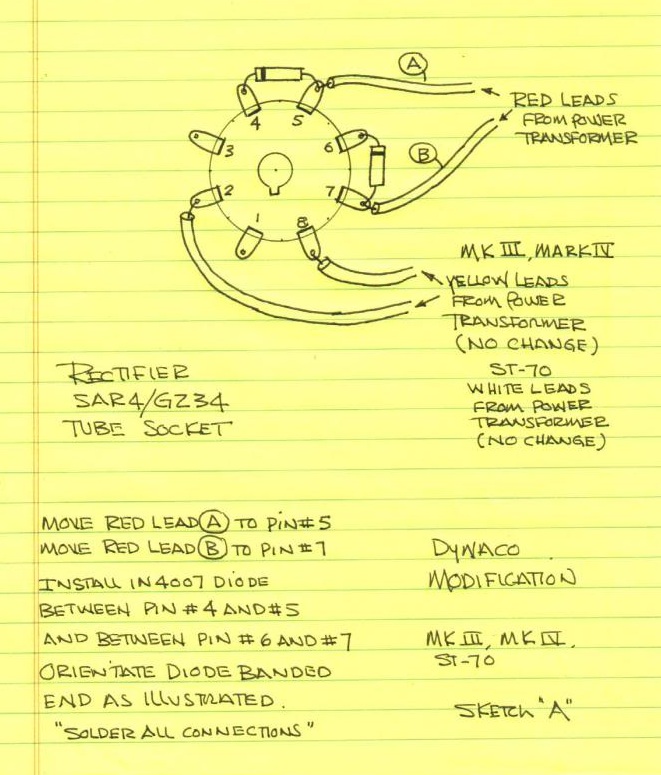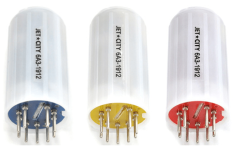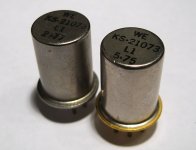Schitt Audio has a preamp that is intriguing the FREYA+. It uses 4 6SN7 tubes. But here's the kicker... you can optionally purchase 4 "solid state" tubes. What are these? Well I assume they would have to be solid state circuits, in a bottle, with an octal base, that simulates the transfer function, curves, mu, rp, etc of a 6SN7 tube? So the circuit still thinks a tube is in the socket. Is this cool or what? Has anyone seen this concept used before with anything other than the old silicon rectifier substitute's?
Does anyone have a schematic of what solid state circuit might be fitted into an octal bottle to precisely impersonate a 6SN7? I'd really be interested in such a circuit that can be a plug in replacement of a tube, for study and interest.
https://www.schiit.com/products/freya-n
Does anyone have a schematic of what solid state circuit might be fitted into an octal bottle to precisely impersonate a 6SN7? I'd really be interested in such a circuit that can be a plug in replacement of a tube, for study and interest.
https://www.schiit.com/products/freya-n
Don't know what they are using, but it sounds similar to this: https://diyaudiostore.com/products/korg-nutube
jeff
jeff
Attachments
This concept also sounds like a good business opportunity in the crazy audiophile world. Developing solid state tubes that just plug into existing tube gear. They would be sold in tube boxes, and look like tubes. Seems it would be much easier than starting a vacuum tube factory these days! I would assume as a mfg of these tubes, you'd have to prove that your SS tube has the same data sheet characteristics of the original tube number. Sorry, just rambling, I just found this whole idea to be intellectually enjoyable.
Many years ago, I did once joke that the ultimate amplifier was a Quad 405 with a hole in the top with a standard filament light bulb plugged into the light socket. So much better than the standard 405. Don't laugh... Jadis actually did this on one of theirs.
kind regards
Marek
kind regards
Marek
I recall an amp that used a tube rectifier. I think it was a 5AR4. One that lights up brightly when on. The socket for the rectifier had a pair of 1N4007 soldered in parallel with the diodes in the tube. The tube was just there for show.
A quick and dirty tube emulator can be made by adding a diode across the feedback resistor in an opamp gain stage. Once the diode starts to conduct it'll generate massive amounts of even-order distortion. You can tweak the sound by adding some resistance in series with the diode and also by the amplitude of the signal that you feed into the circuit.
It doesn't look as cool in the dark as a real tube, though. 🙂
Tom
A quick and dirty tube emulator can be made by adding a diode across the feedback resistor in an opamp gain stage. Once the diode starts to conduct it'll generate massive amounts of even-order distortion. You can tweak the sound by adding some resistance in series with the diode and also by the amplitude of the signal that you feed into the circuit.
It doesn't look as cool in the dark as a real tube, though. 🙂
Tom
A lot of the modern production 5AR4's are a bit weak, so by placing a couple of 1N4007's in series with the plates, you can protect the tube from exceeding it's PIV, and arcing. Someone came up with the "yellow sheet mod".I recall an amp that used a tube rectifier. I think it was a 5AR4. One that lights up brightly when on. The socket for the rectifier had a pair of 1N4007 soldered in parallel with the diodes in the tube. The tube was just there for show.
Gone are the days of robust Mullard GZ34's, that would last for 40 years in a Dynaco ST70.

Last edited:
Why on earth? A semiconductor circuit can likely be made to emulate a tube's characteristics, but what's the point of that? Part of tubes' appeal is their appearance, which would go missing with a S.S. emulation.Schitt Audio has a preamp that is intriguing the FREYA+. It uses 4 6SN7 tubes. But here's the kicker... you can optionally purchase 4 "solid state" tubes. What are these? Well I assume they would have to be solid state circuits, in a bottle, with an octal base, that simulates the transfer function, curves, mu, rp, etc of a 6SN7 tube? So the circuit still thinks a tube is in the socket. Is this cool or what? Has anyone seen this concept used before with anything other than the old silicon rectifier substitute's?
Does anyone have a schematic of what solid state circuit might be fitted into an octal bottle to precisely impersonate a 6SN7? I'd really be interested in such a circuit that can be a plug in replacement of a tube, for study and interest.
https://www.schiit.com/products/freya-n
People who like to repair very old valve radios sometimes a use modern valve disguised as a very old one or even a FET circuit when the real thing is not available.
Agree; if there's no replacement valve available, then kluging something non-tube just to get the equipment going again would be worthwhile.
Gone are the days of robust Mullard GZ34's, that would last for 40 years in a Dynaco ST70.
Mine has lasted more than 40 years, and no series silicon diodes either.
there is an article "Solid Tubes" on page 45 in:
https://www.worldradiohistory.com/Archive-DX/QST/60s/QST-1977-04.pdf
https://www.worldradiohistory.com/Archive-DX/QST/60s/QST-1977-04.pdf
and in QEX august 1997 page 17. You can download 1997 from the KO4BB website
http://ftb.ko4bb.com/manuals/86.85.243.103/QEX_magazine_1997_complete.zip
http://ftb.ko4bb.com/manuals/86.85.243.103/QEX_magazine_1997_complete.zip
Been there, made that. The circuit that I call UNSET uses a pentode, usually a TV sweep tube, to emulate a triode. The curves from the mosfet / pentode combo look just like a triode. I called it UNSET as it works, and sounds like a SET, but contains no real triodes.
It's a simple matter to put another mosfet in place of the pentode to create an all mosfet "triode."
Have a look at the designs in this thread. My involvement starts in post #63 and ends with a prototype amp I call FETSET. It sounds too good to be tubeless and a simple PCB might be in the works. Like a typical Tube based SET it uses an OPT and runs on about 300 volts. Power output is limited by the dissipation rating of the output mosfet and the size of the heat sink it's on. I get 15 to 20 watts from a TO-247 mosfet. My experiments with two paralleled mosfets all ended with fried fets and blown parts. The info is scattered throughout that thread just search it for my user name.
There has been no work on it in quite some time though.
It's a simple matter to put another mosfet in place of the pentode to create an all mosfet "triode."
Have a look at the designs in this thread. My involvement starts in post #63 and ends with a prototype amp I call FETSET. It sounds too good to be tubeless and a simple PCB might be in the works. Like a typical Tube based SET it uses an OPT and runs on about 300 volts. Power output is limited by the dissipation rating of the output mosfet and the size of the heat sink it's on. I get 15 to 20 watts from a TO-247 mosfet. My experiments with two paralleled mosfets all ended with fried fets and blown parts. The info is scattered throughout that thread just search it for my user name.
There has been no work on it in quite some time though.
The amp I'm referring to was some cheapie eBay amp.A lot of the modern production 5AR4's are a bit weak, so by placing a couple of 1N4007's in series with the plates, you can protect the tube from exceeding it's PIV, and arcing.
Tom
- Home
- Amplifiers
- Tubes / Valves
- Designing a solid state tube?

